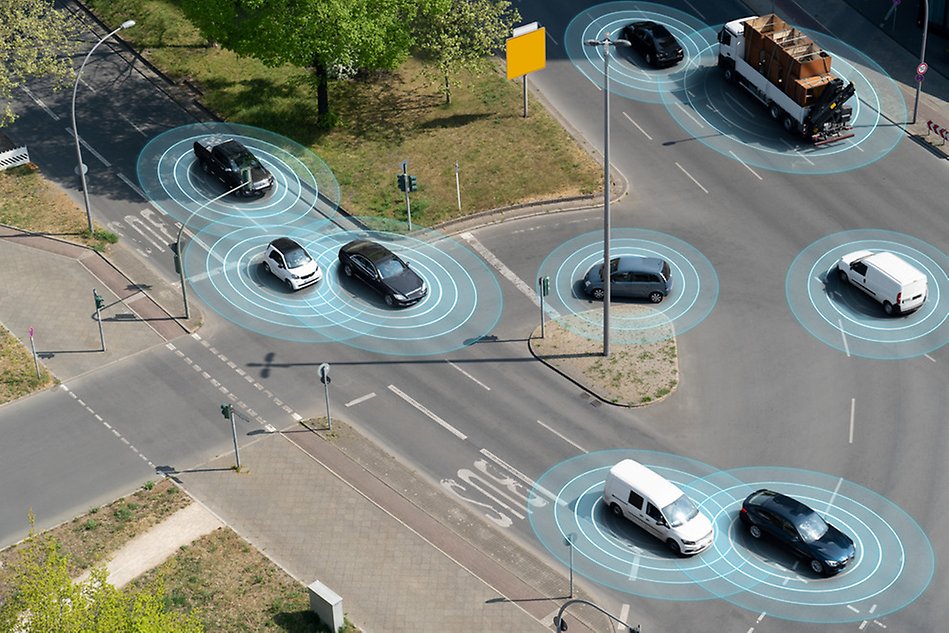SafeSmart – Safety of Connected Intelligent Vehicles in Smart Cities
This project aims at developing technical advances enabling automated driving in challenging urban scenario, for example at an intersection with vulnerable road users.

Our project is focused on connected automated vehicles and methods to enable cooperation between them for the sake of improved road safety. Against this background we define the overall core research question of this project as:
What are the needed engineering advances to guarantee safety of vulnerable road users (VRUs) at cooperative intersections?
Background
Leading automotive industry players are currently introducing more intelligence into the vehicles to increase the level of vehicular automation. Society of Automotive Engineers (SAE) categorises driving automation systems into five levels which span from the release of only specific driver’s functions in specific driving conditions, to the operation anywhere and anytime without a need for the driver. Existing state-of-the-art market solutions reach automation level 4 only for fully segregated guideways (for example special zones in airports). Up-to-date limited-access highway driving assist systems fall into the automation level 2. For city environments only level 1 systems (for example lane keeping assistance) exist.
Importantly, enabling reliable cooperation between vehicles is a crucial component to approaching the problem. Cooperative adaptive cruise control to eliminate shock waves, automated merging of vehicles, starting beyond line of sight, to smoothen traffic, speed harmonization to maximize flow, speed reduction approaching queue for safety are the examples of performance that is only achievable through cooperation. Therefore, connectivity becomes a crucial part of future autonomous vehicles, while current solutions rely exclusively on non-cooperative computer vision paradigm. Against this background we define the overall core research question of this project as:
What are the needed engineering advances to guarantee safety of vulnerable road users (VRUs) at cooperative intersections?
To address this question, we have analysed the state-of-the-art, figured out the missing pieces of knowledge and suggested some research agenda to fill up the gap. The choice of the research sub-questions is motivated by the needed and sufficient advances in autonomous driving:
- First, one needs to detect and localize the VRU (pedestrian, cyclist). The presence of VRUs, which are not necessarily instrumented to communicate, is the main distinguishing feature of city environment in comparison to highway or sub-urban ones. Existing approaches are only limited to the case when optical visibility between the vehicle and VRU is assumed. Therefore, the SL (Sensing & Localization) sub-project studies the ways to detect and localize them at intersections under the obstructed line-of-sight conditions.
- Second, the coordination between the vehicles is only possible when the reliable intervehicular communication is in place. Typically city environment assumes a lot communicating vehicles in the proximity. Although existing vehicular communication technologies provide acceptable performance with a dozen of communicating vehicles, the performance issues arise in really dense city traffic scenarios. Therefore, the CC (Communication & Collaboration) sub-project studies the ways to manage radio resources at intersection with dense vehicular urban traffic, where intensive mutual interference occurs.
- Thirdly, given the first two advances are in place, an automatic control algorithm to pass the intersection safely should be designed. The decisions will be based on the information available from both the localization (about surrounding VRUs) and the communication (about other vehicles) sensors. Each automated vehicle should steer itself, so that the resulting traffic can be certified as safe, what will be the focus of the DC (Decision & Control) sub-project.
SafeSmart is a part of Halmstad University's KK environment Research for innovation. The objective for SafeSmart in this context is to strengthen Halmstad University’s profile area Smart Cities and Communities . This will be achieved by building on Halmstad University’s long term collaboration with the automotive and ICT sectors of Swedish industry. Smart Mobility is an important cornerstone in future smart cities, which is also recognized in the European societal challenge – smart, green and integrated transport.
About the project
Project period:
- September 1, 2019, to February 29, 2024
Financier:
- The Knowledge Foundation
Involved partners:
- AstaZero
- Scania
- H&E Solutions
- Gutec
- Quviq
- Luxoft
Project team:
- Alexey Vinel, Professor, PhD, Synergy Coordinator, CC project leader
- Wojciech Mostowski, Docent, PhD, TI project leader
- Johan Thunberg, PhD, DC project leader
Department:
- CERES

